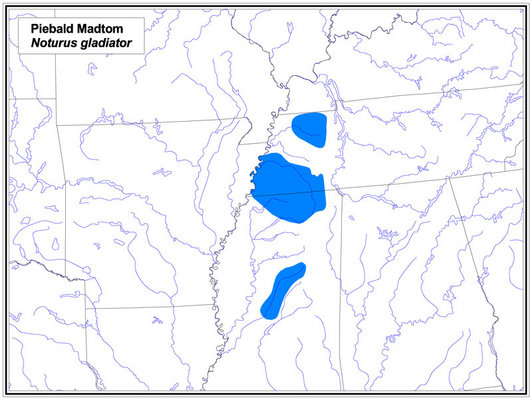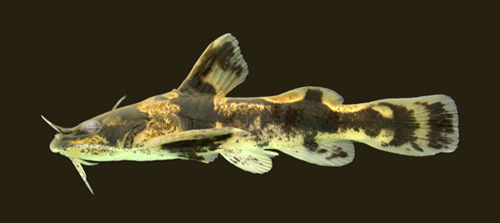Noturus gladiator
Piebald Madtom
Larry PageIdentification
The stout body has boldly contrasting dark brown or black and saddles on the yellow-tan back and sides. The front edge of the 1st saddle is irregular and encloses 2 large light spots in front of the dorsal fin. The fins are blotched or banded. There are dark bands at the base and near the edge of the dorsal fin; these bands are connected along the front of the fin. A dark bar that extends into the upper half of the adipose fin continues down across the body into the anal fin. A dark crescent-shaped band in the middle of the caudal fin extends forward at the center to join the dark pigment on the caudal peduncle; as it does it forms 2 yellow spots at the base of the caudal fin. There is a second band near the clear edge of the caudal fin. The large pectoral spine has 6-12 large teeth on the rear edge and large teeth along the front edge. The rear edge of the high adipose fin reaches the caudal fin but barely connects to it. The rear edge of the caudal fin is straight or has slightly rounded corners. There are 12-15 anal rays. To 5 in. (13 cm) total length.
Range
The Piebald Madtom lives in tributaries of the Mississippi R. in western Tennessee and northern Mississippi from the Obion River system in the north to the Yazoo and Big Black River systems in central Mississippi. It is generally common.


Distribution of Noturus gladiator. © Larry Page
Habitat
The Piebald Madtom is found most often near woody debris in sandy and clay-bottomed runs in creeks and small rivers.
Similar Species
The Nothern Madtom, N. stigmosus, and Frecklebelly Madtom, N. munitus, have a less bold pattern and the dark bar in the adipose fin does not cross the body and connect to the dark bar in the anal fin. Also, the dark crescent-shaped band in the middle of the caudal fin is these species is not connected to the dark pigment on the caudal peduncle (or, at most, there may be a thin line of connecting pigment), and yellow spots at the base of the caudal fin are indistinct.
About This Page
Larry Page

Florida Museum of Natural History, Gainesville, Florida, USA
Correspondence regarding this page should be directed to Larry Page at and Griffin Sheehy at
Page copyright © 2007 Larry Page
All Rights Reserved.
- First online 23 May 2007
- Content changed 23 May 2007
Citing this page:
Page, Larry. 2007. Noturus gladiator . Piebald Madtom. Version 23 May 2007 (under construction). http://tolweb.org/Noturus_gladiator/69870/2007.05.23 in The Tree of Life Web Project, http://tolweb.org/








 Go to quick links
Go to quick search
Go to navigation for this section of the ToL site
Go to detailed links for the ToL site
Go to quick links
Go to quick search
Go to navigation for this section of the ToL site
Go to detailed links for the ToL site